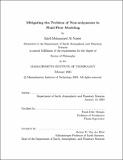| dc.contributor.advisor | Morgan, Frank Dale | |
| dc.contributor.author | Al Nasser, Saleh Mohammed | |
| dc.date.accessioned | 2023-03-31T14:37:53Z | |
| dc.date.available | 2023-03-31T14:37:53Z | |
| dc.date.issued | 2023-02 | |
| dc.date.submitted | 2023-02-16T18:22:52.518Z | |
| dc.identifier.uri | https://hdl.handle.net/1721.1/150179 | |
| dc.description.abstract | Modeling fluid flow in porous media is a valuable and essential tool for developing underground resources such as hydrocarbon reservoirs, groundwater aquifers, or CO₂ sequestration projects. The modeling, if done accurately, can provide a reliable forecast of future fluid behavior. However, the properties of the porous media and the correct solutions to the physics equations describing the macroscopic fluid flow are essential to ensure accurate modeling and, consequently, reliable forecasts. Therefore, the need to discretize the porous mediums into a large number of grids is often crucial to capture the observed data's behavior. And because the data has a low abundance spatially, it is impossible to model the fluid flow uniquely. In the thesis, we study ways to transform the modeling of fluid flow in porous media into a less non-unique problem by exploring different models and data spaces. By reducing the number of grids, we quantitatively demonstrate the possibility of producing more accurate representations of reservoirs. Also, through the resolution matrix analysis and the use of Shannon information entropy, we developed a method to acquire data adaptively for an optimum survey design. Additional data sets from self-potential or seismic surveys have complemented the fluid flow data in different joint inversion methods. sing self-potential data allows the detection of fractures with higher confidence. The seismic data was used in a cross-gradient joint inversion scheme to constrain the inversion of fluid flow data. The joint inversion helped in around 16% reduction in the seismic velocity root-mean-square-error (RMSE) and almost 26% decrease in the permeability RMSE. | |
| dc.publisher | Massachusetts Institute of Technology | |
| dc.rights | In Copyright - Educational Use Permitted | |
| dc.rights | Copyright MIT | |
| dc.rights.uri | http://rightsstatements.org/page/InC-EDU/1.0/ | |
| dc.title | Mitigating the Problem of Non-uniqueness in Fluid-flow Modeling | |
| dc.type | Thesis | |
| dc.description.degree | Ph.D. | |
| dc.contributor.department | Massachusetts Institute of Technology. Department of Earth, Atmospheric, and Planetary Sciences | |
| mit.thesis.degree | Doctoral | |
| thesis.degree.name | Doctor of Philosophy | |
